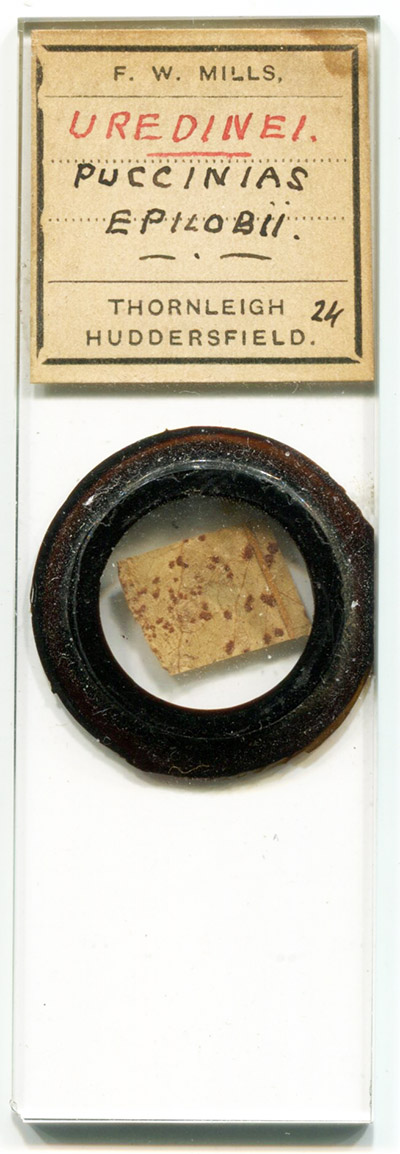
Figure 1. A botanical microscope slide with Frederick Mills' label. Another slide by Mills is illustrated in Brian Bracegirdle's "Microscopical Mounts and Mounters", Plate 26-O. "Thornleigh" was the name of Mills' house.
Frederick William Mills, 1868 - 1949
by David Walker
last updated March, 2020
F.W. Mills will be a name likely to be most familiar to diatom enthusiasts, his publications on diatoms include a popular introduction (now back in print) and an important, comprehensive index to the genera and species. His microscopy interests also included the foraminifera and botanical specimens (Figure 1). The obituary by his friend and fellow diatomist Norman Hendey, presents a fascinating man of many talents; by profession, Frederick Mills was a very successful solicitor but his interests included photography (with an international award in his teens), motorcycling (an early pioneer), ocean going yachting, sports, and was an accomplished painter in both oil and water colours (1). By the age of 27 he had five published books on photography as well as his introduction to the diatoms.
My own interest in F.W. Mills was piqued because he was born and lived his working life in Huddersfield; his house 'Thornleigh' still exists and is less than two miles from my home. Coincidentally he published studies of the diatoms and foraminifera of the Hull area, which is the city where I was born and brought up, so many of the localities are familiar. Hendey's eloquent and informative two page obituary of F.W. Mills describing his life, work and character is a delight to read, written with the insight of a friend; interested readers are recommended to obtain a copy. This article hopes to present some aspects of F.W. Mills' life and work which being local to Huddersfield and the resources of the web permits.

Figure 1.
A botanical microscope slide with Frederick Mills' label. Another slide by Mills is illustrated in Brian Bracegirdle's "Microscopical Mounts and Mounters", Plate 26-O. "Thornleigh" was the name of Mills' house.
Prepared microscope slides
Hendey provides an insight into Mills' slide collection and preparations: "He amassed one of the largest collections of microscope slides of diatoms ever held in private hands, although he claimed that he never mounted a specimen himself. He sold the entire collection of about 30,000 slides to the late Frederick Adams. The collection is now in the keeping of the British Museum (Natural History).
This is in contrast to the noted diatomist John A. Long, who lived ten miles north of Mills in Bradford, and was an almost exact contemporary; Long was a prolific mounter of diatom slides and his slides often crop up in sales. Given Hendey's comment, it is possible that slides with F.W. Mills labels just indicate ownership rather than the preparer.
Given the close proximity of three noted diatomists, Frederick Mills, John Albert Long and Dingley Fuge, it's interesting to speculate if they liaised extensively on their diatom interests. To date I've found no record of such liaison.
Aspects of family life and career
Frederick William Mills was born in 1868 to Charles Mills and his wife Emma (née Walker) who lived in 'Thornleigh', Edgerton. He was their only son. His father was a solicitor in Huddersfield and a biographical note of the time is reproduced below (Figure 2)
Figure 2.
Entry for Charles Mills, Frederick's father, in W. Herbert Scott's "The West Riding of Yorkshire at the Opening of the Twentieth Century. Contemporary Biographies", 1902. This image and that in Figure 3 are from the fascimile of the book on CD published by Anguline Research Archives, and is reproduced with their kind permission.
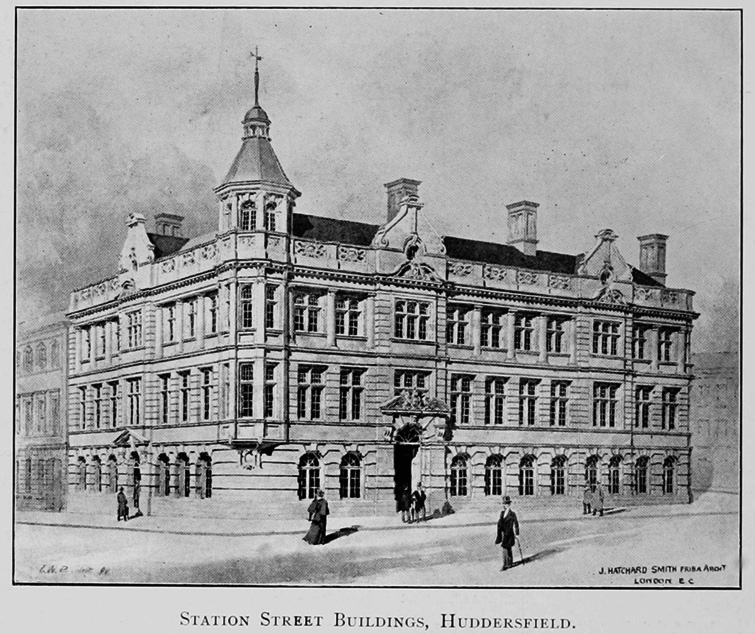
Figure 3.
The elegant building in the centre of Huddersfield where Charles Mills ran a solicitor's practice with his partner. Frederick later joined the firm. This building still exists and is now a Grade II listed building.
Hendey notes that Charles Mills' practice served many of the wealthy industrialists of Huddersfield, a town noted for its textile industries in particular, sadly a local industry now much declined. The success of this practice may be reflected in the Mills' home in Edgerton, an affluent village suburb of Huddersfield. A fascinating history of the 'Village of Edgerton' can be read at the Around Town website
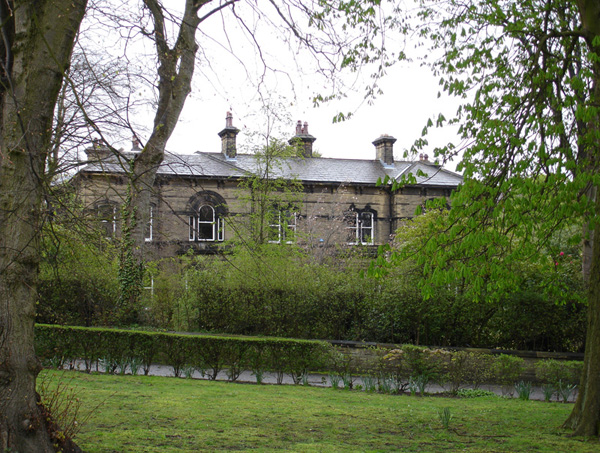
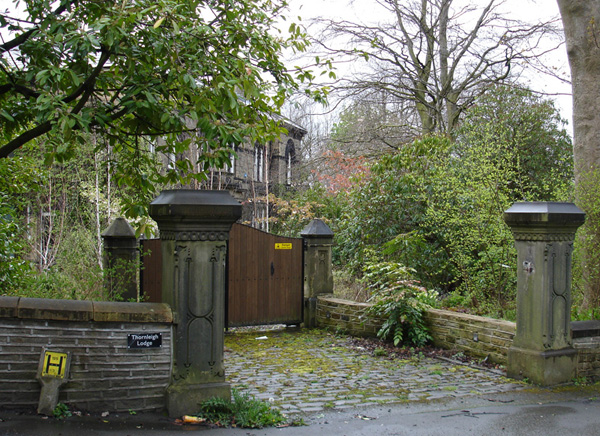
Figure 4.
Thornleigh Lodge, Bryan Road, Edgerton, today, photos taken by the author. The still retains much of its 'feel' from the 19th century with 'leafy' roads and large, widely separated houses often set back in their own extensive grounds. Until 2001 Thornleigh was documented as a care home but this closed and believe now a private residence. A number of other large properties in the area are care homes, business addresses or converted to student accommodation for the local university. A 2009 property sale site for Thornleigh Lodge that is archived online shows the spacious and modernised interiors and landscaped garden.
The 1881 census shows Frederick Mills, aged 12, as a boarder at Hillbrow Preparatory School, Rugby. Hendey notes that Frederick was "educated at Rugby", which may suggest that Frederick later attended Rugby School, one of the oldest and prestigious English Public Schools, but no record of his attendance has been found to date
By 1891, Frederick, now aged 23, was back living at his parents home, Thornleigh, and working as an "articled clerk" at his father's firm of solicitors. Hendey notes that Frederick worked as a solicitor in Huddersfield until he retired in 1922. Frederick married Emily (aged ca. 23, née Greenwood) in 1919 in Ripon, North Yorkshire where his wife was born. Public census records stop at 1911 and it's uncertain from searches to date if they had any children after marrying.
The me��mbership lists of the Quekett Microscopical Club of which Frederick was a member (and later elected to Honorary Member) give four addresses:
1922 - Fyling Hall, near Robin Hoods Bay, North Yorkshire. This may be the now Fyling Hall School (established 1923) or Flying Old Hall
1927 - Tormohun Court, Middle Warbury Road, Torquay, Devon. No record found to date in 'Middle Warberry Road, Torquay'.
1933, 1936, 1939 - Woodford Hall, Milton Damerel, North Devon.
1948, 1949 - Petticombe, Monkleigh, North Devon.
The success of Frederick Mills' business as a solicitor is probably reflected in the extensive country properties where he lived in his retirement; at least three of the above remain today and two of his later residences are illustrated below. He died at his home 'Petticombe', Monkleigh, North Devon in October 5th 1949 aged 82. His wife later remarried Geoffrey Tinker and she died in Norwich, aged 99 in 1995. The general locale of his retirement addresses are popular holiday areas, noted for their beautiful countryside and coasts, and likely settings for Frederick to pursue his interests.
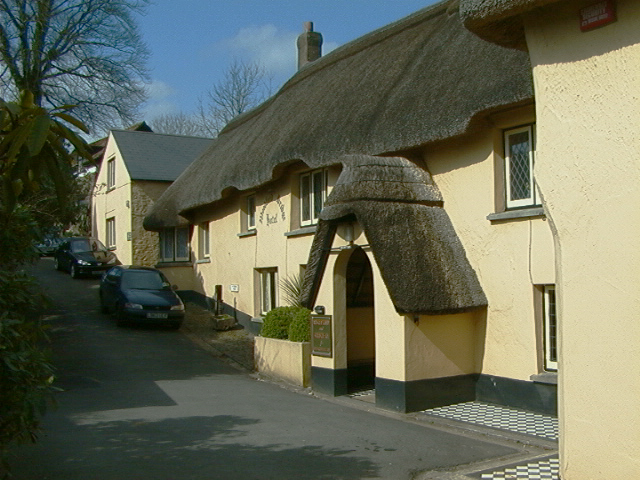
Figure 5.
The "Woodford Bridge Country Club", Milton Damerel, North Devon today with thatched roof. It used to be a coaching inn and from information kindly supplied by a local historian, it is believed to be the Woodford Hall where Frederick Mills lived in the 1930s. Image credit: © CopyrightAndy Potter, and licensed for reuse under Creative Commons. Image source: http://www.geograph.org.uk/.
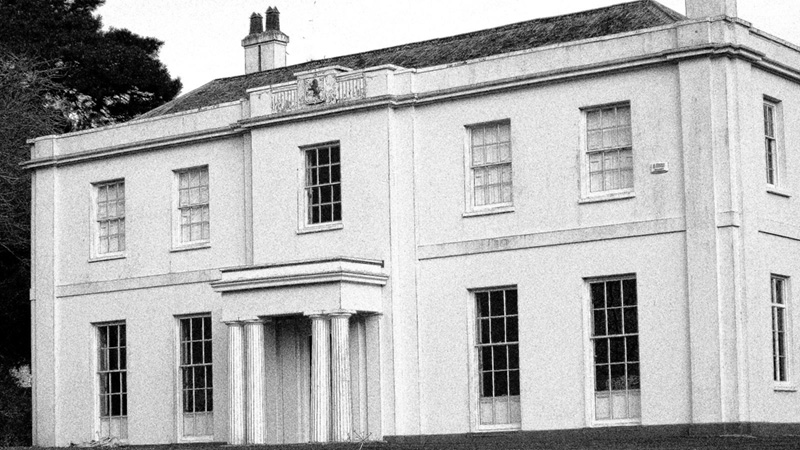
Figure 6.
"Petticombe Manor", which was Frederick Mills' home at the time of his death, is an impressive house in a delightful setting, built in 1805 and now a Grade II listed building. Artwork by Christina Smith created from an original colour photo taken by the son of the house owners. Shared (resized from the master) with their permission with the help of David Hogan. Originally hosted on the Landcross Community Association Website.
Aspects of Frederick Mills' interests:
Photography
Hendey notes that Mills became an "expert" photographer and that he "won the Premier Award at the Vienna International Exhibition of Photography" when a teenager. To date I've been unable to find further information on this award or of his winning photograph(s). The Exhibition may have been that held in 1888. The later, better known, exhibition in 1891 would have been when Mills was in his twenties.
Frederick had five books published on photography by the age of 27; this accomplishment suggests a quick development of expertise and the confidence to publish his own work in an increasingly crowded publishing marketplace. The biographical entry of his father Charles Mills shared earlier, notes that he was a published author, including the literary work "Attic Nights" in 1879 (back in print). Charles Mills' own experience of having published may have aided his son.
Photography for Architects (64 pp) and The Art and Practice of Interior Photography (123 pp, 3 plates, 5 pp photo ads, were both published ca. 1890 by Iliffe and Son, London. I haven't seen copies of either of these books, but were advertised in his later book on photomicrography (see below).
Stenopaic and Pin-hole Photography (28 pp) and The Photographer's Exposure Book were both published in 1895.
Photography Applied to the Microscope, 1891, Iliffe and Son, London (78 pp), was co-authored with T. Charters White who is credited with writing the chapter on 'Mounting Objects'. It can be read online at http://archive.org, but is also back in print with various publishers.
Mills' family background and spacious house may have permitted a dedicated darkroom and access to photographic equipment at an early age to develop skills he could share. His parent's house and surrounding properties of Edgerton may also have been useful to practice and develop skills at interior photography and of architecture.

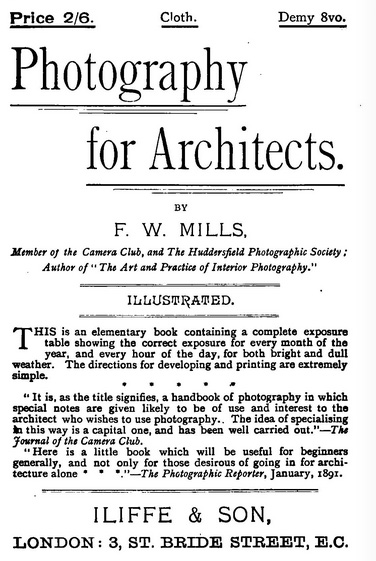
Figure 7.
Adverts with reviews of two earlier books by Frederick Mills, printed in the back of his 1891 photomicrography book. The favourable reviews shows that the author's work was well received.
Microscopy based studies - photomicrography, foraminifera, and diatoms:
Frederick Mills' comments on choice of microscope, optics and other equipment in his book Photography Applied to the Microscope provide an insight into the instruments he was using and/or familiar with. He remarks in Chapter II 'Microscopical Apparatus' (p.20):
"The author considers the form adopted in Watson and Sons' microscopes the best. He has used one of the "D" Edinburgh student stands for a considerable time, and fails to perceive the slightest deterioration as a result of wear, even with higher power objectives."
His later comments (p.22) on which objectives are suitably corrected for photography, suggest hands-on experience of a range of both English and continental makers' optics. Hendey (1) notes that "He [Mills] held strong views about the excellence of British microscopes and optical apparatus, and did not favour those of continental manufacture.".
Foraminifera
Hendey does not mention Frederick Mill's work on the Foraminifera in his Obituary but it was listed as a co-interest along with the Diatomaceae in the 'Quekett' Membership list of 1949. Mills published a paper "Recent Foraminifera of the River Humber, Part 1" in the first volume of the Transactions of the Hull Scientific and Field Naturalists' Club, 1898, pp. 142-150 with two plates, one plate is shown below. I haven't to date sourced later parts. F.W. Mills was also listed as source of the most Foraminifera records presented in The Victoria History of the County of York, volume I, 1907 which also references his work published in The Naturalist, 1901.
In the list of Officers in Volume II 1902 of the Hull Club's Transactions, F.w. Mills is listed as the Recorder for the Foraminifera and R.H. Philip for the Diatomaceae.
The late Brian Davidson kindly informed me that Mills was a "friend / patron of Arthur Earland", the noted expert on the foraminifera and whose many prepared foram slides included a 1500 form which Mills purchased. Arthur Earland is known to have made type slides for Mills. Brian was custodian of the 'Earland Collection' and had correspondence between Mills and Earland.
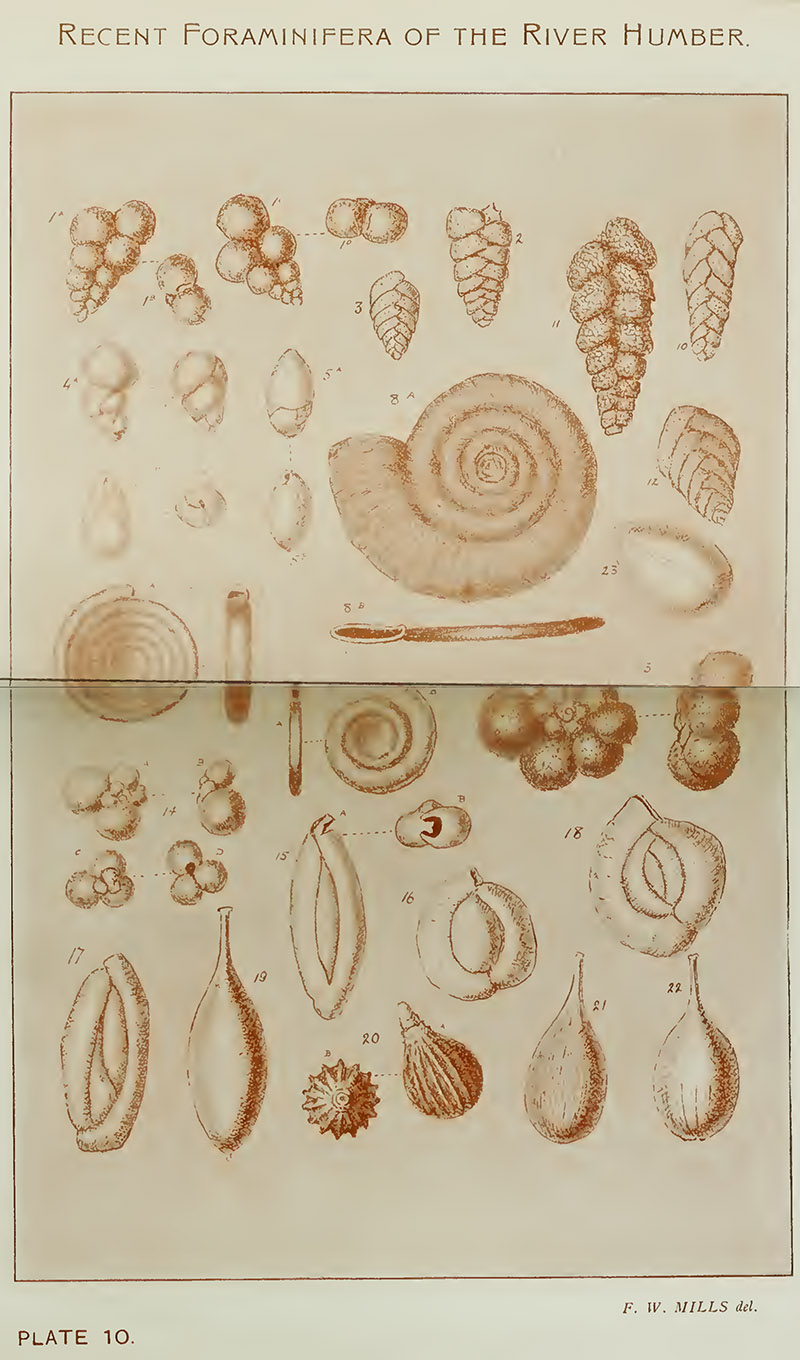
Figure 8.
One of the two plates drawn by Frederick Mills in his 1898 paper on the Foraminifera.
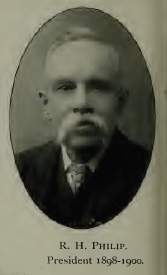
Figure 9.
R.H. Philip who is credited in the paper as supplying the Humber river sample. Philip was the first president of the "Hull Club" and also co-authored with Frederick their paper on "The Diatomaceae of the Hull District".
Diatoms
F W Mills' obituarist Norman Ingram Hendey was a noted diatomist, and provides an authoritative summary of Mills' work on diatoms. As a hobbyist with limited diatom knowledge, I just offer short general notes on some of the major publications with links to online copies where available.
Frederick Mills' book An Introduction to the Study of the Diatomaceae was published in 1893 by Iliffe and Son when he was aged 25. In the Preface, the author notes his own difficulties in learning about the diatoms and thus the need for an accessible and affordable introduction for others. This book is back in print as a facsimile copy and widely available, e.g. from Amazon, as is the paper on the Hull diatom flora below. It was co-authored by Julien Denby who wrote the extensive Bibliography which occupies the larger part of the book. A review of the book by 'W.B.T' in The Naturalist, 1893, pp.262-263 was rather mixed.
In Chapter VIII, entitled "Microscopical Examination of Diatoms", Mills extends his advice on suitable stands and optics beyond those mentioned in his earlier book on photomicrography. He recommends Beck's "Bacteriological Star Microscope" as "The most efficient of the cheaper stands ..". After recommending most of the major English makers he remarks: "If, however, a really first-class stand is required, the author has a preference for Messrs. W. Watson and Sons' 'Van Heurck' ". The 'Van Heurck', in its variants, was Watson's flagship stand, first issued in 1891 and continued in production for some decades later. It is regarded by historians to be one of the finest stands ever made, with a price to match at the time - and now - when they come up for sale! If Mills owned an example rather than just having access perhaps via his club and society contacts, his wealthy family background and profession as solicitor may have allowed him to afford this top of the range model.
Mills published his paper co-authored with R.H. Philip, "Diatomacea of the Hull District" in 1901. Both this and his earlier paper on Foraminifera (1898) were published in the first volume of the Transactions of the Hull Scientific and Naturalists Club. Frederick Mills' support for this Club's first publications was acknowledged in the Preface to Volume 1, no. 1 (1898) (Figure 10).
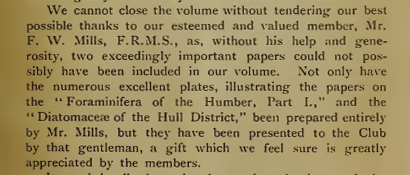
Figure 10.
An extract from the Preface of Volume 1, Number 1, 1898, of the "Transactions of the Hull Scientific and Naturalists' Club".
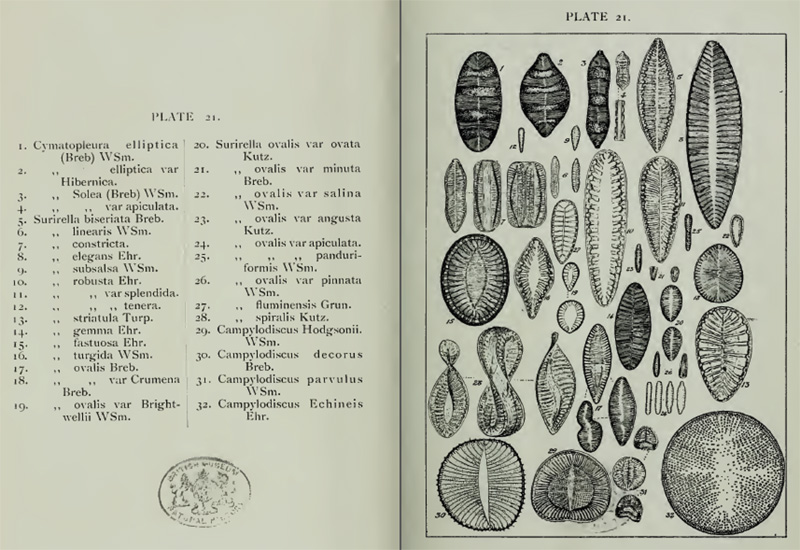
Figure 11.
One of the attractive plates which accompanied Mills and Philip's 1901 paper on the Hull diatom flora. The authors acknowledge in the text that many diatoms were drawn based on the figures from past author's work but new drawings were required for some species.
From 1933 - 1935, Frederick Mills published An Index to the Genera and Species of the Diatomaceae and Their Synonyms, in 21 parts. Hendey describes this as Mills' "magnum opus", later a "monumental work" and who discusses the background to its publication and its importance

Figure 11.
Part 1 of "An Index to Genera ..".
My own interest in aspects of Frederick Mills' life, greatly aided by Hendey's Obituary for providing leads, was prompted by Mills living very locally as well as his microscopy interests. But in addition to his best known and important diatom studies, he was clearly a man of many talents, shared these with others in his publications and lived life to the full.
To date, I have been unable to trace a photograph of Frederick Mills to share that is out of copyright. If any reader knows of one I would be interested to hear from them.
Acknowledgements
I would like to thank the following people for their invaluable help while preparing this article. However, any errors or omissions are solely mine:
Steve Gill for sharing his own independent study of the ancestry of the F W Mills and his wider family which added valuable records to the author's own study.
Brian Stevenson for sourcing a copy of one reference and for valuable discussions and insight on 19th and early 20th century slide makers.
Wendy Adams, an archivist at Rugby School, for kindly checking the Rugby School Registers of scholars.
David Hogan, Trustee of the Littleham and Landcross Community Web Site Association for kindly seeking permission to use the Petticombe Manor artwork and for providing details on the image.
Guy Etchells of Anguline Research Archives for permission to share extracts from their CD ref. ARA 490.
Terry Fairbrother of the Milton Damerel Community website and local historian Grace for valuable information on the likely identity of 'Woodford Hall'.
David Spencer, webmaster of the PhotoSeed website sub-titled "Bringing to Light the Growth and Artistic Vision of 19th and 20th Century Photography",for a valuable insight into the photographic exhibitions at Vienna in the late 19th century and for suggested references.
Brian Davidson for an example of Mills bookplate (below), the image of a Mills slide, and for information on F.W. Mills - Arthur Earland connection.
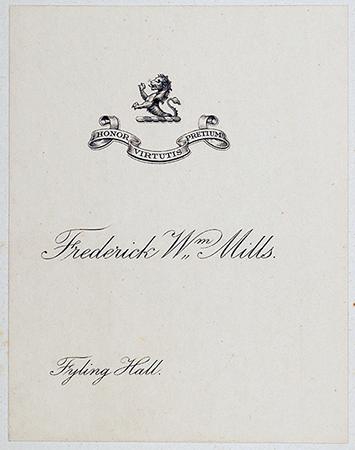
Figure 13.
Brian Davidson kindly sent an example of a bookplate from one of Mills' books when living in retirement at Fyling Hall. (Note this is printed and not Mills' signature.)
Additional references and resources not linked to in the text
Obituary Frederick William Mills. (1868-1949)' signed 'N.I.H.' i.e. Norman Ingram Hendey, Journal of the Royal Microscopical Society*, 1950, vol. 70, (3), pp. 292-293. (* Mills was elected to Fellowship of the Royal Microscopical Society in 1912
Obituaries also written by Hendey were published in the Proceedings of the Linnean Society**, 1951, vols. 162-164, and a condensed entry in the Quekett Journal of Microscopy, 1950, vol. 206, part 3, p.205. (** Mills was elected a Fellow of the Linnean Society in 1918
Obituaries for Norman Ingram Hendey himself were published in the Phycologist , 2005, 68 (Spring), p. 10-11 by Gerald Boalch and Diatom Research, 2005, vol. 20. no. 2, pp. 417-424.
Ancestry record searches: The author's own using Find my Past - birth, censuses up to 1911. Supplemented by the more extensive and wider family records compiled by Steve Gill and kindly shared.
B. Bracegirdle, Microscopical Mounts and Mounters, Quekett Microscopical Club, 1998. Entry for 'MILLS, F.W.', p.67 and plate 36, slide 'O'
The Journal of the Quekett Microscopical Club***, 1868 - 1992, CD-ROM Edition. (*** Mills was elected a Member of the Club in 1913 and as an Honorary Member in 1948
David Spencer, webmaster of the PhotoSeed website. Personal communication. He kindly suggested that the journal Photographische Rundschau (link is to PhotoSeed's description of the Journal) may provide information on Mills' photographic award but likely editions of the period ca. 1888-1890 have not been readily accessible to date.
��������The website http://www.antique-microscopes.com/photos/watsonvan.htm has some splendid photographs of the Watson 'Van Heurck' microscope models, a historical summary and extracts from Watson's catalogues describing the stand.
First published in the May, 2012 edition of Micscape (revised March 24th 2012).
http://www.microscopy-uk.org.uk/mag/artmay12/dw-fwmills.htmlThis edition hosted by Brian Stevenson on microscopist.net, with permission of the author